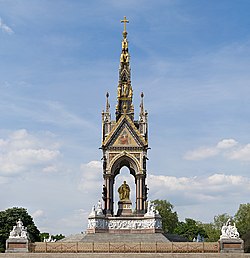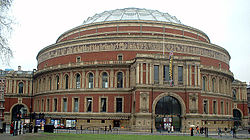Albertopolis

Albertopolis is the nickname given to the area centred on Exhibition Road in Kensington, Middlesex containing a large number of educational and cultural sites, many created at the inspiration of Prince Albert the Prince Consort or named in memory of him. The site is in South Kensington, in an area bordered by Cromwell Road to the south and Kensington Road to the north.
Institutions




Institutions in and around Albertopolis include:
- Imperial College London
- Natural History Museum
- Royal Albert Hall
- Royal College of Art
- Royal College of Music
- Royal Geographical Society
- Royal Institute of Navigation
- Science Museum
- Victoria and Albert Museum
- Albert Memorial
The following were originally institutions in their own right:
- City & Guilds College, now a subsidiary of Imperial College as the City and Guilds of London Institute
- Geological Museum, now a subsidiary of the Natural History Museum
- Royal College of Science, now a subsidiary of Imperial College
- Royal School of Mines, now a subsidiary of Imperial College
Institutions formerly in Albertopolis include:
- Royal College of Organists, from 1904 to 1991.
- Royal School of Naval Architecture, from 1864 to 1873.
- Royal School of Needlework, from 1903 to 1987.
- Imperial Institute, later Commonwealth Institute, from 1893 to 1962.
History
Following the advice of Prince Albert[1] the area was purchased by the Royal Commission for the Exhibition of 1851 with the profits made from the Great Exhibition of 1851, which was held in a site in Hyde Park nearby to the north-east. This is commemorated in the name of the principal north-south street laid out on their estate, Exhibition Road.
Prince Albert was a driving force behind the Great Exhibition and President of the Royal Commission, and the name "Albertopolis" seems to have been coined in the 1850s to celebrate and somewhat satirise his role in Victorian cultural life. After his death the term fell into disuse, and the area was more widely referred to as South Kensington. It was revived by architectural historians in the 1960s and popularised by the nascent conservation movement to bring attention to the complex of public Victorian buildings and the surrounding houses built on the Commissioners' estate, that were threatened with demolition by the expansion and redevelopment plans of Imperial College. Among the buildings threatened was the Imperial Institute,[2] designed by Thomas Edward Collcutt.
Overview
- Location map: 51°29’53"N, 0°10’36"W
There is a central axis between the Albert Memorial in Kensington Gardens to the north and the central portal of the south façade of the Natural History Museum. The Royal Albert Hall, Royal College of Music, the former tower of the otherwise-demolished Imperial Institute (now the Queen's Tower of Imperial College London) and the 1950s rear extension to the Science Museum are all aligned on this axis, which cannot be seen on the ground. This regular geometric alignment of Albertopolis can be observed readily only from the balconies of the Queen's Tower (very rarely open to visitors), although the northern part can be glimpsed from the top floor of the Science Museum.
The closest tube station is South Kensington, linked to the museums by a tiled tunnel beneath Exhibition Road constructed in 1885. The tunnel originally continued as a covered route to the south porch of the Royal Albert Hall by way of a second tunnel, subsequently used for a period as Imperial College's shooting range, emerging into the arcades and conservatory of the former gardens of the Royal Horticultural Society.
Outside links
- Albertopolis online exhibition, from the Royal Institute of British Architects
- Architectural Tour of Exhibition Road and 'Albertopolis' from the Victoria and Albert Museum
- Royal Commission for the Exhibition of 1851
- Survey of London: volume 38: South Kensington Museums Area F. H. W. Sheppard (editor). Originally published by the Athlone Press for the Greater London Council, 1975. Available online as part of British History Online.
- Walking tour of Albertopolis Podcast, PDF and map.
References
- ↑ "South Kensington From Above: 1856 – 1862". http://www.architecture.com/LibraryDrawingsAndPhotographs/Albertopolis/ExploringSouthKensington/SouthKensingtonFromAbove/1856-1862.aspx. Retrieved 2010-12-10.
- ↑ "Demolition of the institute and expansion of Imperial College". http://www.architecture.com/LibraryDrawingsAndPhotographs/Albertopolis/TheStoryOf/ImperialCollege/DemolitionOfTheInstitute.aspx. Retrieved 2010-12-10.